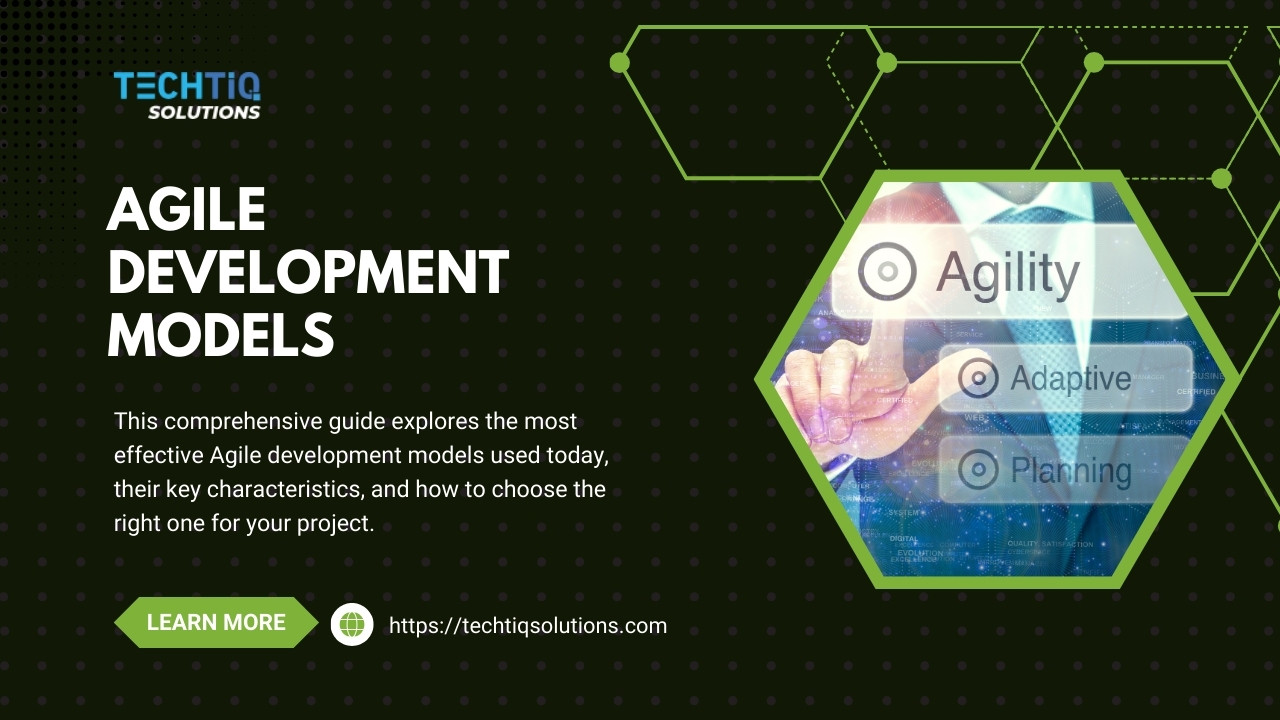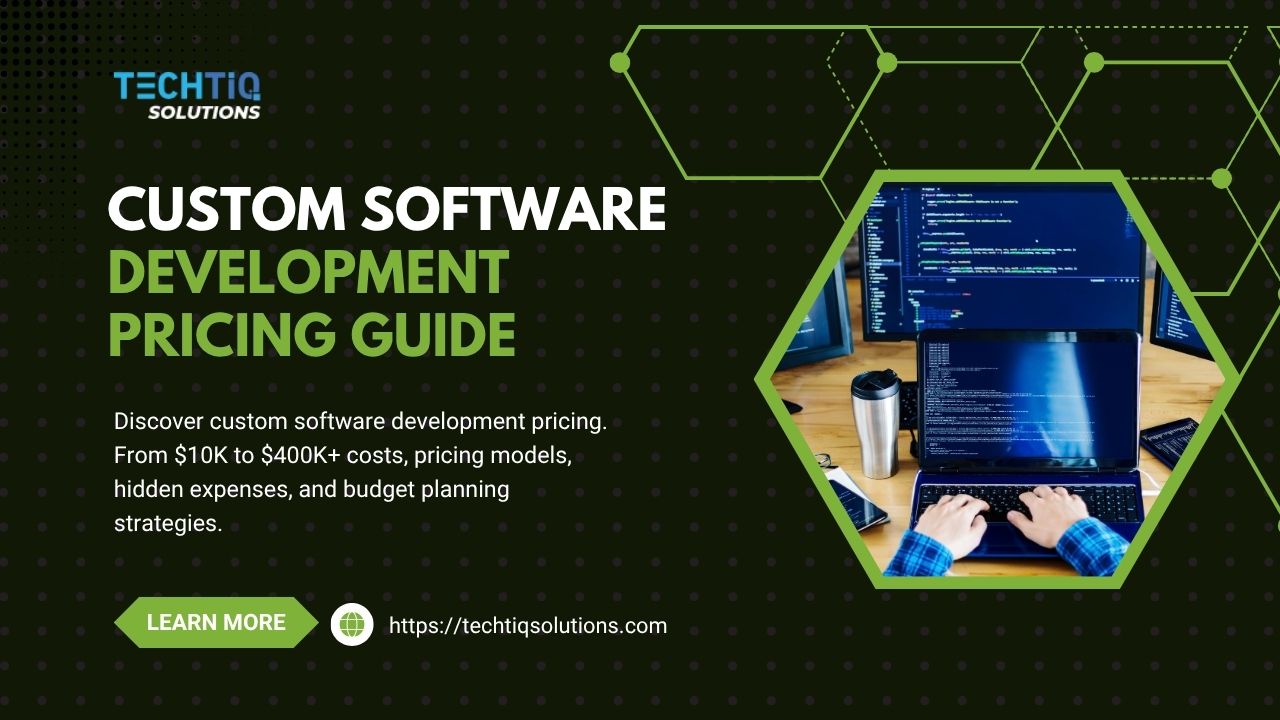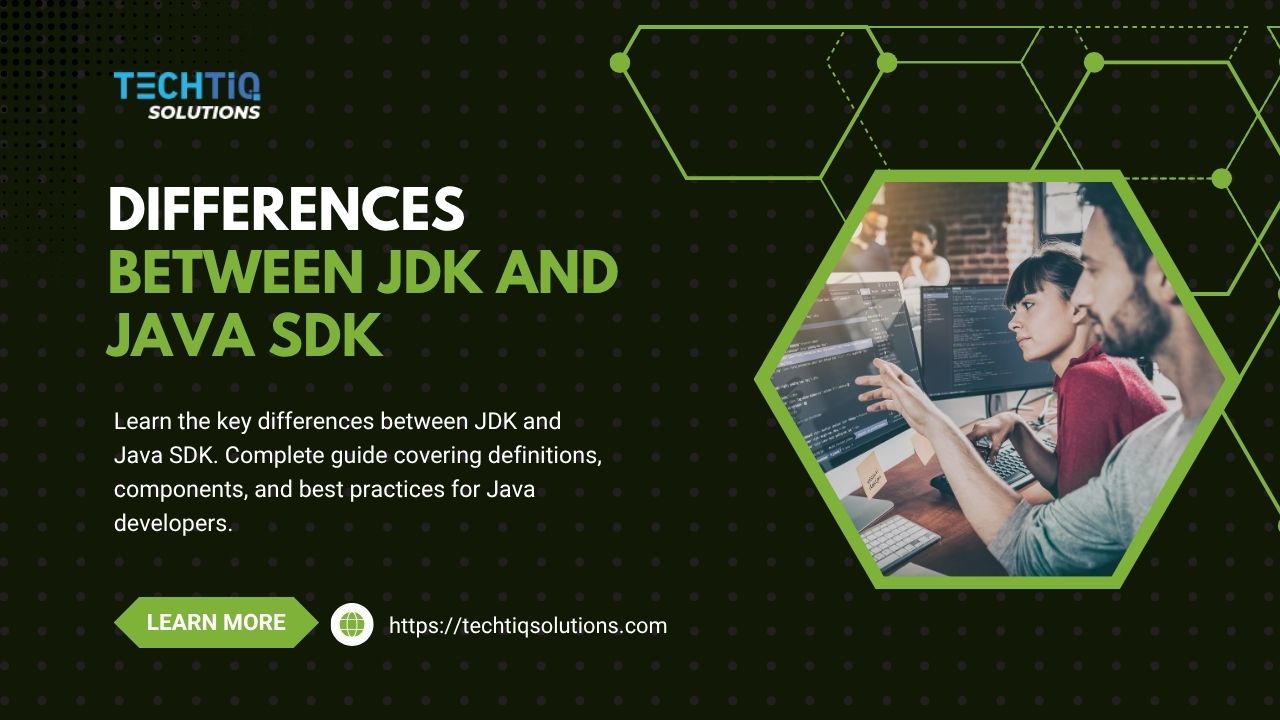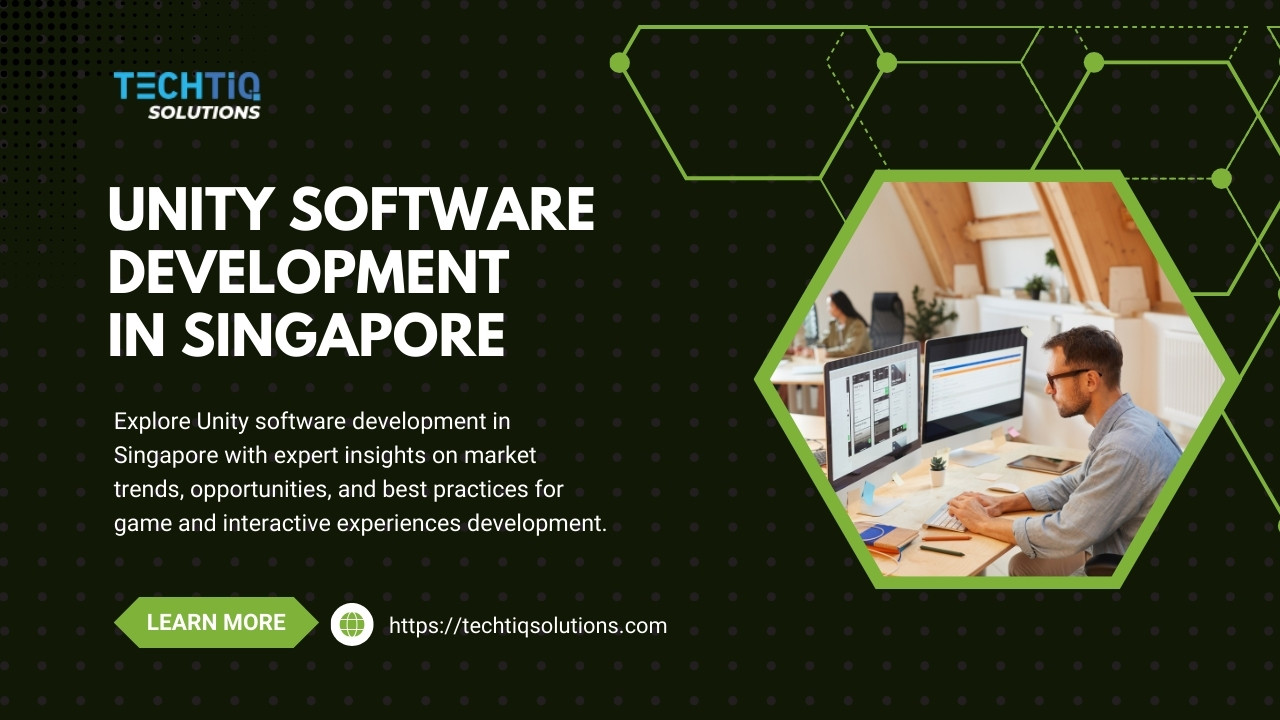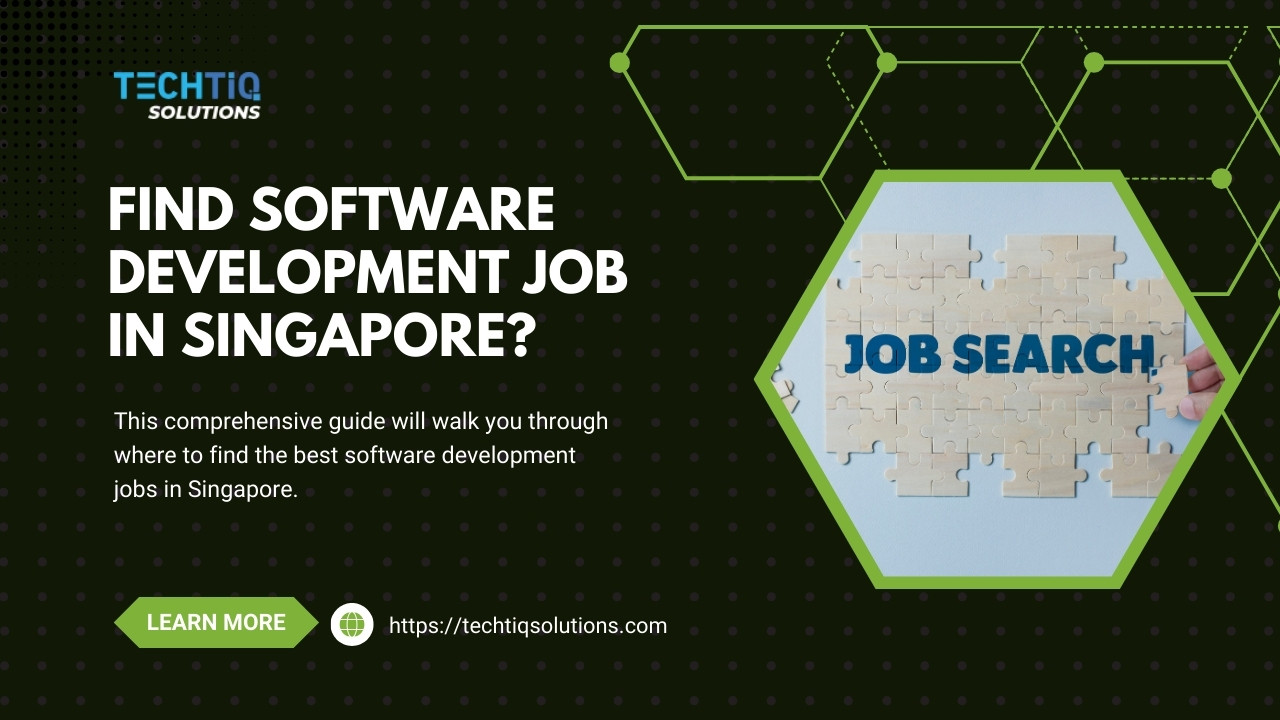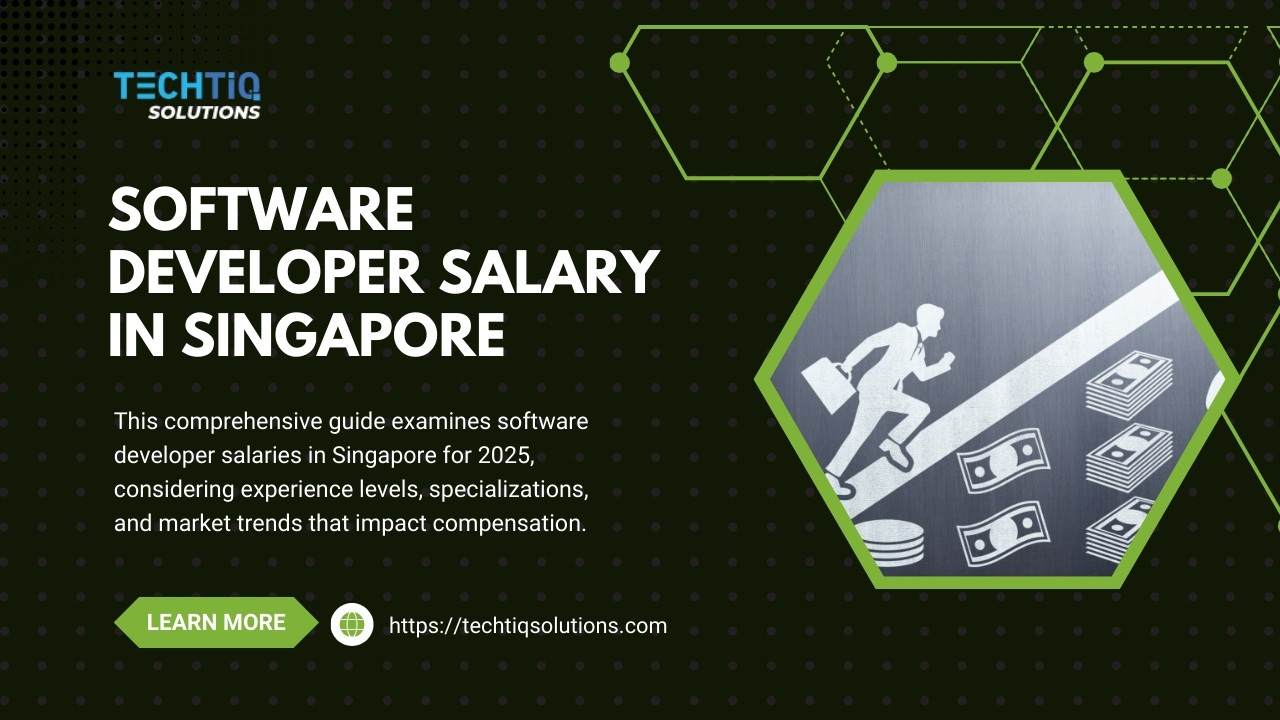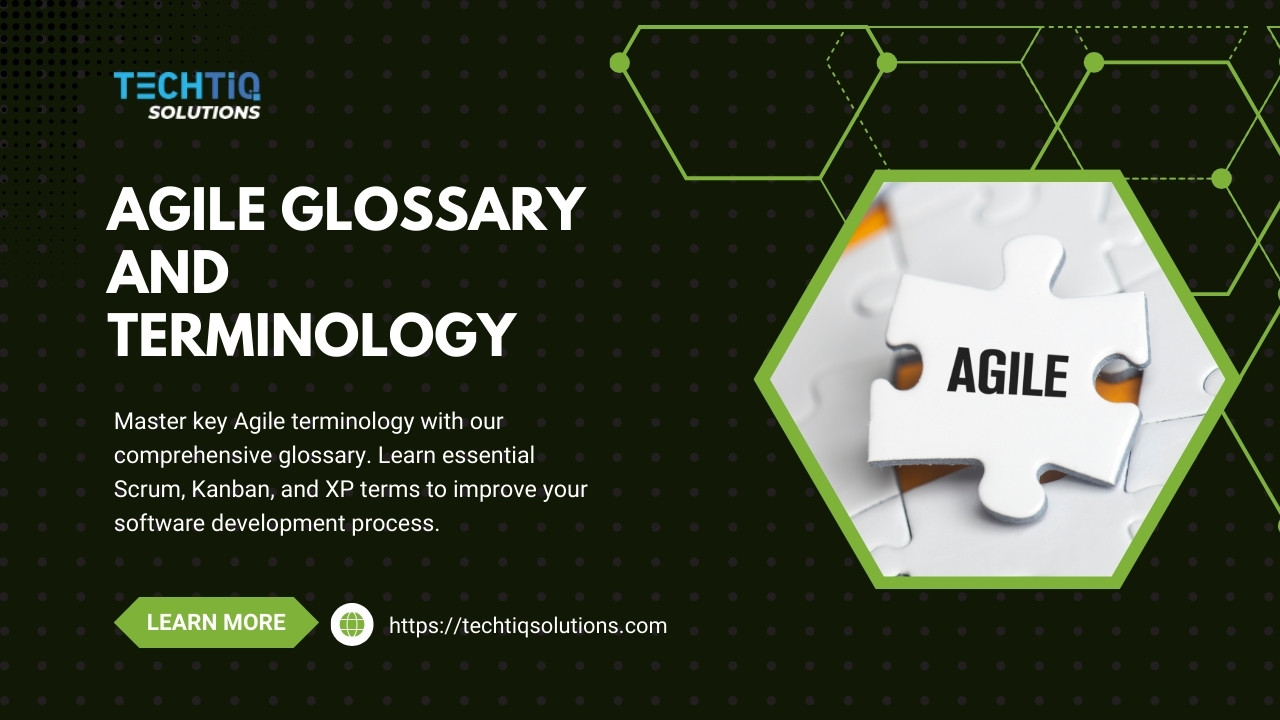Ever wondered why some software teams seem to deliver results faster and with better quality? The secret often lies in their development model. Traditional software development approaches frequently led to missed deadlines, budget overruns, and products that didn’t meet user needs. This is where Agile development models changed the game.
This comprehensive guide explores the most effective Agile development models used today, their key characteristics, and how to choose the right one for your project. We’ll also share real implementation examples from TechTIQ Solutions’ experience across various industries and project types.
Key Takeaways
Agile development models prioritize flexibility, collaboration, and customer value over rigid planning
Different Agile models (Scrum, Kanban, XP, etc.) serve different project needs and organizational contexts
Successful implementation requires understanding each model’s strengths, limitations, and best use cases
Hybrid approaches often provide the best results by combining elements from multiple Agile models
TechTIQ Solutions has successfully implemented various Agile models across diverse projects
What Are Agile Development Models?
Agile development models are frameworks that implement the values and principles outlined in the Agile Manifesto. Unlike traditional waterfall approaches that follow a linear, sequential path, Agile models embrace iterative development, frequent delivery, and continuous feedback.
The core philosophy behind all Agile models includes:
Delivering working software frequently (weeks rather than months)
Welcoming changing requirements, even late in development
Close collaboration between business stakeholders and developers
Building projects around motivated individuals and trusting them
Face-to-face conversation as the most efficient communication method
Working software as the primary measure of progress
Sustainable development pace that teams can maintain indefinitely
Continuous attention to technical excellence and good design
Simplicity—maximizing the amount of work not done
Self-organizing teams that generate the best architectures and designs
Regular team reflection and adaptation to improve effectiveness
While all Agile models share these foundational principles, each implements them differently, with varying ceremonies, artifacts, roles, and practices.
The PACE Framework for Agile Selection
To help organizations select the most appropriate Agile model, we’ve developed the PACE Framework—a structured approach to evaluating your project needs and organizational context:
P – Project Characteristics
Assess your project’s complexity, requirements stability, time constraints, and criticality. Complex projects with evolving requirements typically benefit from structured frameworks like Scrum, while maintenance projects with frequent priority shifts often perform better with Kanban.
A – Adaptive Capacity
Evaluate your organization’s readiness for change, including leadership support, team autonomy, and cultural alignment with Agile values. Less mature organizations may need more structured approaches initially.
C – Coordination Requirements
Consider how many teams need to collaborate, geographic distribution, and integration challenges. Larger, distributed efforts may require scaled frameworks like SAFe or LeSS.
E – Expertise Available
Honestly assess your team’s experience with Agile methods, technical practices, and domain knowledge. Some models (like XP) require significant technical discipline, while others (like Kanban) can be easier to adopt initially.
By evaluating these four dimensions, you can narrow down which Agile model will best serve your specific context.
Popular Agile Development Models
1. Scrum
Scrum is perhaps the most widely adopted Agile framework, used by approximately 66% of Agile teams according to industry surveys. It provides a structured approach with clearly defined roles, events, and artifacts.
Key Characteristics:
Roles: Product Owner, Scrum Master, Development Team
Time-boxed iterations (Sprints) typically lasting 2-4 weeks
Daily Scrums (Standups) for team synchronization
Sprint Planning to determine what will be delivered in the upcoming Sprint
Sprint Review to inspect the increment and gather feedback
Sprint Retrospective to improve processes and practices
Artifacts: Product Backlog, Sprint Backlog, Increment
Best For:
Scrum works particularly well for complex projects with changing requirements where the final product isn’t completely defined at the outset. It’s ideal for teams that benefit from regular checkpoints and structured collaboration.
Limitations:
Scrum can feel rigid for some organizations, especially those unfamiliar with its specific roles and ceremonies. It requires dedicated roles (particularly the Product Owner and Scrum Master) and works best with stable, dedicated teams.
Common Pitfalls and How to Avoid Them:
Treating Scrum as a rigid methodology: Remember that Scrum is a framework, not a prescriptive methodology. Adapt it to your context while preserving its core principles.
Poor Product Owner availability: Ensure your Product Owner has adequate time allocated to the role and authority to make decisions about the product.
Scrum Master as project manager: The Scrum Master should focus on facilitating the process and removing impediments, not managing the team or the project.
Neglecting technical practices: Scrum focuses on process but doesn’t prescribe technical practices. Consider incorporating XP practices to maintain code quality.
Treating the Sprint as a mini-waterfall: Avoid the tendency to spend the first part of the Sprint designing, the middle part coding, and the last part testing. Work should flow continuously throughout the Sprint.
2. Kanban
Kanban originated in lean manufacturing and focuses on visualizing workflow, limiting work in progress, and maximizing flow efficiency. Unlike Scrum’s fixed iterations, Kanban promotes continuous delivery.
Key Characteristics:
Visual workflow management using a Kanban board
Work in Progress (WIP) limits for each stage of development
Continuous flow rather than time-boxed iterations
Pull system where new work is only started when capacity allows
Cycle time and lead time as key metrics
Minimal prescribed roles or ceremonies
Best For:
Kanban excels in maintenance and support environments where priorities frequently change. It’s ideal for teams with variable workloads or when continuous delivery is more important than batch planning. Teams transitioning from traditional methods often find Kanban less disruptive initially.
Limitations:
Without time-boxed iterations, some teams may lack the regular cadence for planning and reflection that Scrum provides. Kanban offers fewer built-in opportunities for stakeholder feedback compared to Scrum’s sprint reviews.
Common Pitfalls and How to Avoid Them:
Not enforcing WIP limits: WIP limits are essential to Kanban’s effectiveness. Enforce them strictly to reveal bottlenecks and maintain flow.
Missing feedback loops: Without Scrum’s built-in ceremonies, teams need to establish their own cadence for feedback and improvement discussions.
Poor visualization: Ensure your board accurately reflects your actual workflow, including all queue states and dependencies.
Ignoring metrics: Measure and monitor cycle time, lead time, and throughput to identify improvement opportunities.
Treating Kanban as “no process”: While Kanban is flexible, it still requires discipline and continuous improvement to be effective.
3. Extreme Programming (XP)
XP focuses intensely on engineering practices and technical excellence. While other models address project management aspects, XP emphasizes programming practices that improve code quality and team productivity.
Key Characteristics:
Pair programming with two developers working together at one machine
Test-Driven Development (TDD) writing tests before code
Continuous Integration (CI) merging code changes frequently
Simple design that evolves as needed rather than over-engineering
Refactoring to improve code without changing behavior
Collective code ownership where anyone can modify any code
Small, frequent releases to deliver value quickly
On-site customer deeply involved in development
Best For:
XP is particularly effective for projects requiring high quality and reliability. It works well for teams comfortable with significant collaboration and technical discipline. XP practices enhance other Agile models when code quality is paramount.
Limitations:
XP’s engineering practices require significant discipline and skill. Some practices, like pair programming, may face resistance in traditional organizations. XP also requires a higher level of customer involvement than some other models.
Common Pitfalls and How to Avoid Them:
Cherry-picking practices: XP’s practices reinforce each other. Implementing only some practices reduces their effectiveness.
Inadequate automated testing: TDD and continuous integration depend on robust testing. Invest in building a comprehensive test suite.
Resistance to pair programming: Start with targeted pairing sessions for complex tasks or knowledge transfer rather than full-time pairing.
Insufficient customer involvement: Work with business stakeholders to ensure they understand the importance of their involvement and make it easy for them to participate.
Technical debt accumulation: Without discipline in refactoring and simple design, technical debt can accumulate rapidly. Schedule regular refactoring sessions.
4. Lean Software Development
Adapted from Toyota’s manufacturing principles, Lean Software Development focuses on eliminating waste and optimizing the whole value stream. It provides a philosophy and set of principles rather than specific practices.
Key Characteristics:
Eliminate waste in all forms (partially done work, extra features, task switching, etc.)
Amplify learning through short feedback cycles and set-based development
Decide as late as possible to maintain options
Deliver as fast as possible to get feedback
Empower the team to make decisions
Build integrity in through refactoring and testing
Optimize the whole value stream, not just parts
Best For:
Lean principles benefit organizations seeking to optimize their entire development process. It works well as a foundation for other Agile practices, helping teams identify and eliminate inefficiencies throughout their workflow.
Limitations:
As a set of principles rather than specific practices, Lean requires more interpretation to implement. Organizations typically need to combine Lean thinking with more prescriptive models like Scrum or Kanban for day-to-day guidance.
5. Feature-Driven Development (FDD)
FDD focuses on building features that deliver client value, with a strong emphasis on design and quality. It combines model-driven development with Agile practices.
Key Characteristics:
Five processes: Develop overall model, build feature list, plan by feature, design by feature, build by feature
Regular delivery of tangible features
Class ownership with clear responsibility for code areas
Feature teams formed for specific features
Inspections to ensure code quality
Regular builds to verify integration
Visible progress tracking based on completed features
Best For:
FDD suits larger teams and projects where features can be clearly defined. It provides more structure than some Agile methods, making it appealing for organizations transitioning from traditional approaches.
Limitations:
FDD places less emphasis on customer collaboration and iteration than other Agile models. It requires experienced chief programmers and domain experts to be effective.
Agile Models Comparison Chart
This comparison chart provides a quick reference to help you understand the key differences between major Agile models, including their best applications, team size recommendations, key strengths, challenges, and implementation complexity.
Hybrid and Scaled Agile Models
Scrumban
Scrumban combines elements of Scrum and Kanban, using Scrum’s ceremonies with Kanban’s flow-based approach. Teams typically maintain Sprint planning, reviews, and retrospectives while using a Kanban board with WIP limits for daily work management.
Best For:
Scrumban works well for teams transitioning from Scrum to Kanban or those wanting Scrum’s structure with Kanban’s flexibility. It’s particularly effective for maintenance teams handling both planned work and unplanned requests.
Scaled Agile Framework (SAFe)
SAFe provides a structured approach for implementing Agile practices at enterprise scale. It organizes work around a “Portfolio,” “Program,” and “Team” level, with specific roles and ceremonies at each.
Key Characteristics:
Agile Release Trains (ARTs) as cross-functional teams delivering value
Program Increments (PIs) as 8-12 week planning horizons
Built-in quality practices from XP
DevOps integration for continuous delivery
Lean-Agile Leadership training
Portfolio management with strategic themes
Best For:
SAFe suits large organizations with multiple teams working on complex products. It provides the structure and governance that enterprises often require while maintaining Agile principles.
Large-Scale Scrum (LeSS)
LeSS takes Scrum principles and scales them to multiple teams working on the same product, with minimal additional overhead.
Key Characteristics:
Single Product Backlog across all teams
One Product Owner for the entire product
Synchronized Sprints across teams
Cross-team coordination with Scrum of Scrums and other techniques
Overall Retrospective in addition to team retrospectives
Best For:
LeSS works well for organizations wanting to scale Scrum with minimal additional complexity. It’s suited for products that naturally decompose into components that different teams can work on relatively independently.
Disciplined Agile (DA)
DA provides a toolkit approach to scaling Agile, allowing teams to select practices that work best for their context. It emphasizes decision-making guidance rather than prescribing specific practices.
Key Characteristics:
Process goal diagrams showing options for achieving specific outcomes
Guided continuous improvement with suggested evolution paths
Multiple life cycles (Agile, Lean, Continuous Delivery, Exploratory)
Full delivery lifecycle from concept to retirement
Enterprise awareness connecting team to organization
Best For:
DA suits organizations wanting flexibility to choose their own practices while still having guidance. It works well for diverse environments with different types of projects and teams.
Agile Model Decision Tree
Use this decision tree as a starting point to identify which Agile model might best fit your current context. Remember that this is a simplification – your specific situation may require a more nuanced approach or a hybrid model.
Choosing the Right Agile Model for Your Project
Selecting the most appropriate Agile model depends on various factors including project characteristics, team composition, organizational culture, and business requirements.
Project Considerations
Complexity: More complex projects often benefit from Scrum’s structure
Stability of requirements: Highly volatile requirements favor Kanban’s flexibility
Size: Larger projects may need scaled approaches like SAFe or LeSS
Criticality: Mission-critical systems might benefit from XP’s technical practices
Innovation level: Highly innovative projects might need more exploration phases
Team Considerations
Size: Smaller teams can often use simpler approaches like Kanban
Distribution: Distributed teams may need more formal communication channels
Experience level: Experienced teams can often handle less prescriptive models
Technical expertise: XP requires strong technical skills and discipline
Organizational Considerations
Agile maturity: Organizations new to Agile often start with Scrum or Kanban
Governance requirements: Highly regulated industries may need more structure
Customer involvement: Models vary in how much customer participation they require
Cultural alignment: Some models require more cultural change than others
Common Pitfalls and How to Avoid Them
Regardless of which Agile model you choose, be aware of these common implementation challenges:
1. Focusing on Practices Over Principles
Pitfall: Teams follow Agile practices mechanically without understanding the underlying principles.
Solution: Invest in proper Agile education that emphasizes values and principles. Regularly reflect on how practices serve these principles and adapt them as needed.
2. Insufficient Leadership Support
Pitfall: Management expects Agile results but doesn’t provide the necessary support or changes to organizational policies.
Solution: Secure executive sponsorship before starting, educate leaders on their role in Agile transformation, and identify policy changes needed for success.
3. Attempting Too Much Change Too Quickly
Pitfall: Organizations try to implement all Agile practices at once, overwhelming teams and creating resistance.
Solution: Start with basic practices, establish a rhythm, and gradually add more sophisticated practices as teams gain experience.
4. Neglecting Technical Excellence
Pitfall: Teams focus on process improvements while neglecting technical practices, leading to mounting technical debt.
Solution: Incorporate technical excellence practices like automated testing, continuous integration, and refactoring from the beginning.
5. Insufficient Training and Coaching
Pitfall: Teams are expected to self-organize without adequate training or guidance.
Solution: Invest in proper training for all team members and consider external coaching, especially during the initial implementation.
Transitioning Between Agile Models
As organizations evolve, they may need to transition between different Agile models. Here are strategies for common transitions:
Waterfall to Scrum
This is often the first step in an Agile transformation. Focus on:
Start with education: Ensure everyone understands Agile principles and Scrum practices
Begin with a pilot team: Select a suitable project and team for initial implementation
Establish the rhythm: Focus on mastering the basic Scrum events before adding complexity
Address organizational barriers: Identify and remove policies that conflict with Agile principles
Expect resistance: Prepare for challenges and maintain open communication
Scrum to Kanban
Teams may transition from Scrum to Kanban when they need more flexibility or are dealing primarily with maintenance work:
Start visualizing flow: Introduce a Kanban board while maintaining Scrum events
Introduce WIP limits: Gradually implement and refine work-in-progress limits
Evolve ceremonies: Modify or replace Scrum events with appropriate Kanban cadences
Shift metrics: Move from velocity to flow metrics like cycle time and throughput
Maintain improvement practices: Don’t lose the continuous improvement mindset
Single Team to Scaled Agile
When growing from one team to multiple teams working on the same product:
Ensure strong foundations: Verify that single-team Agile practices are working well
Choose an appropriate scaling approach: Select SAFe, LeSS, or another model based on your context
Start with minimal viable scaling: Add only the coordination mechanisms you absolutely need
Focus on integration: Pay particular attention to how work integrates across teams
Evolve based on feedback: Regularly inspect and adapt your scaling approach
Real-World Applications: TechTIQ Solutions Case Studies
At TechTIQ Solutions, we’ve implemented various Agile models across diverse projects. Here are examples of how we’ve applied different approaches to achieve optimal results:
Bike To Work Mobile App: Scrum Implementation
For the Bike To Work mobile app development project, TechTIQ Solutions implemented Scrum to manage the complex requirements and external dependencies.
Project Challenge:
The app needed to track fitness activities using GPS, display detailed statistics, and enable social sharing. A particular challenge was working with a backend team in Norway with language barriers.
Agile Implementation:
Two-week sprints with clear goals
Daily standups to address communication challenges
Sprint reviews with stakeholders for regular feedback
Technical backlog to address GPS tracking accuracy issues
Results:
Successful delivery despite communication challenges
High-accuracy GPS tracking implementation
Smooth integration with external APIs and services
Positive user feedback on the app’s performance
Mobile Team Manager: Kanban for Maintenance
For the Mobile Team Manager platform, TechTIQ Solutions adopted a Kanban approach for ongoing maintenance and feature development.
Project Challenge:
The platform needed continuous updates and enhancements while maintaining support for existing users. Requirements frequently changed based on user feedback and market conditions.
Agile Implementation:
Visualized workflow with a digital Kanban board
WIP limits enforced to maintain quality and flow
Classes of service to handle both urgent fixes and planned features
Daily team coordination without fixed iterations
Results:
Reduced lead time for critical fixes
Improved predictability for feature delivery
Enhanced team collaboration and transparency
Higher customer satisfaction with response times
Enterprise Software Integration: Hybrid Approach
For a complex enterprise software project, TechTIQ Solutions implemented a hybrid model combining elements of Scrum, XP, and SAFe.
Project Challenge:
The project involved integrating multiple systems across departments with varying requirements and technical interfaces. It required coordination between multiple teams and stakeholders.
Agile Implementation:
Scrum framework for team-level organization
XP practices for technical excellence (pair programming, TDD)
SAFe-inspired program-level coordination
Cross-functional feature teams focused on end-to-end delivery
Results:
Consistent delivery of integrated functionality
High code quality with minimal defects
Effective coordination across teams
Maintained business alignment throughout the project
Implementing Agile Models Successfully
Regardless of which Agile model you choose, certain factors are critical for successful implementation:
Leadership Support
Executive sponsorship and understanding are essential. Leaders must champion the Agile transformation, remove organizational impediments, and model Agile values.
Training and Coaching
Invest in proper training for all team members and stakeholders. Consider external coaches for the initial implementation phase to guide teams through the transition.
Tool Selection
Choose appropriate tools to support your Agile implementation. For distributed teams, digital tools for backlog management, visualization, and communication are particularly important.
Cultural Alignment
Address cultural barriers to Agile adoption. Foster transparency, collaboration, and psychological safety where team members can express concerns and ideas openly.
Metrics and Measurement
Establish appropriate metrics to track progress and improvements. Focus on outcome-based metrics rather than just activities or outputs.
Continuous Improvement
Implement regular retrospectives and feedback loops. Use these insights to adapt and evolve your Agile implementation over time.
Evolving Your Agile Approach
Agile adoption is a journey, not a destination. Most organizations evolve their approach over time as they gain experience and as their context changes.
Common evolution patterns include:
Starting simple: Beginning with basic Scrum or Kanban before adding complexity
Hybrid models: Combining elements from different approaches as needed
Customization: Adapting practices to suit specific organizational needs
Scaling gradually: Expanding from team-level to organizational Agile
Continuous refinement: Regularly inspecting and adapting the approach
The key is maintaining the core Agile values while evolving the specific practices to meet your organization’s changing needs.
Conclusion
Agile development models have revolutionized how software is built, enabling teams to deliver higher quality products that better meet user needs. From structured frameworks like Scrum to flexible approaches like Kanban to technically-focused methods like XP, each model offers unique advantages for different contexts.
The most successful organizations don’t adopt Agile models rigidly but adapt them to their specific circumstances. They understand that Agile is fundamentally about responding to change, delivering value, and continuous improvement.
As demonstrated by TechTIQ Solutions’ experiences across diverse projects, the key to success lies in selecting the right model for your specific context, implementing it thoughtfully, and continuously evolving your approach based on results and feedback.
Whether you’re building mobile applications, enterprise systems, or custom software solutions, Agile development models provide a powerful foundation for delivering exceptional results in today’s dynamic business environment.
Ready to Implement the Right Agile Model for Your Project?
TechTIQ Solutions has extensive experience implementing various Agile development models across diverse projects. Our team can help you select and implement the most appropriate approach for your specific needs.
Contact us to discuss how we can support your Agile transformation or development project:
Email: inquiry@techtiqsolutions.com
Phone: (+65) 8898 2997
Address: 28 Sin Ming Lane #02-145, Midview city, Singapore 573972
Frequently Asked Questions
How do I know which Agile model is right for my organization?
Consider your project complexity, team size and distribution, organizational culture, and business requirements. For teams new to Agile, Scrum often provides the necessary structure to start. Organizations with changing priorities might prefer Kanban’s flexibility. Complex, large-scale projects might need scaled frameworks like SAFe or LeSS.
Can we combine different Agile models?
Yes, many organizations create hybrid approaches by combining elements from different Agile models. For example, you might use Scrum’s ceremonies with Kanban’s visualization and flow, or incorporate XP’s technical practices within a Scrum framework. The key is maintaining consistency and clear expectations across the team.
How long does it take to implement an Agile model effectively?
While basic practices can be implemented quickly, developing true agility typically takes 6-12 months as teams adapt their mindset and optimize their processes. Large organizations implementing scaled Agile models may need 1-3 years to fully transform. Remember that Agile adoption is a continuous journey of improvement, not a one-time implementation.
Do Agile models work for fixed-price or fixed-scope projects?
Yes, but they require adaptations. For fixed-scope projects, you might use an Agile model internally while maintaining a more traditional contract structure externally. For fixed-price work, consider dividing the project into smaller, well-defined increments with separate agreements. Many organizations use a “money for nothing, changes for free” contract structure to maintain flexibility.
How do we measure the success of our Agile implementation?
Focus on outcome-based metrics rather than just compliance with practices. Key indicators include improved time-to-market, higher product quality (fewer defects), increased customer satisfaction, better team morale, and enhanced ability to respond to changes. Also measure business outcomes like revenue growth, market share, or cost reduction attributable to your Agile implementation.
